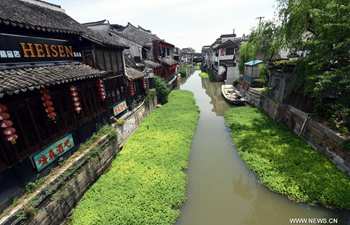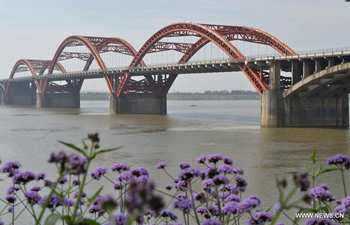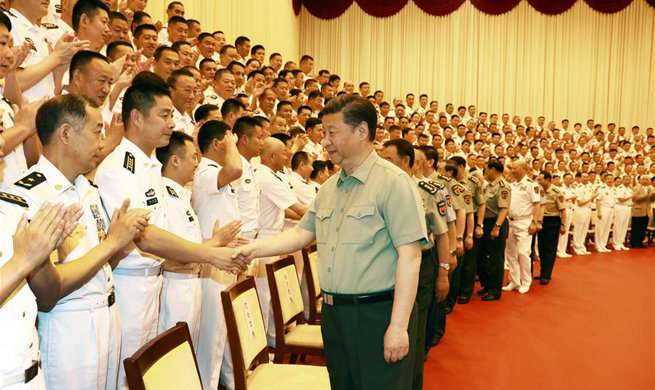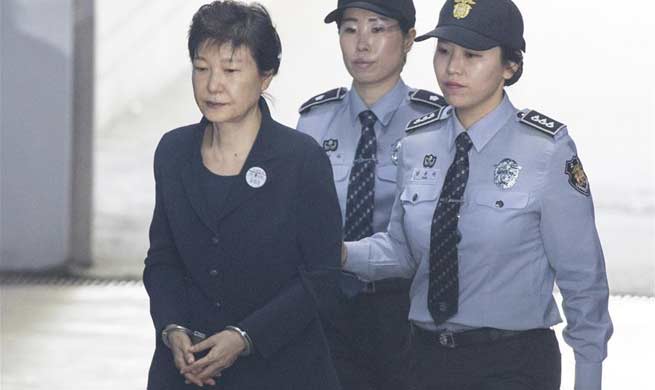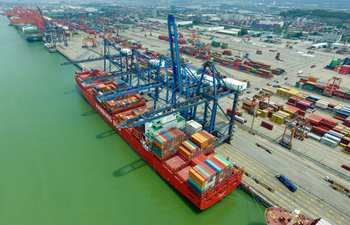by Xinhua writers Yu Zhongwen, Shang Xu, Ma Qian
BEIJING, May 25 (Xinhua) -- Since China proposed the Belt and Road Initiative in 2013, traditional trade and production centers in China's Guangdong Province, represented by such cities as Guangzhou and Dongguan, have seen and seized the new opportunities for further development.
Guangzhou, the capital city of Guangdong Province in southern China, is a traditional business and trade center, while Dongguan was among the first regions growing rapidly after China adopted the reform and opening-up policy in late 1970s.
Facilitated by the Belt and Road Initiative, the two cities have stepped up efforts to upgrade their industrial structures, trade and business environments, and transportation facilities, to best combine their traditional advantages with new opportunities.
NEW INDUSTRIES
As a vanguard of reform and opening-up for decades, Guangzhou has been in the lead in promoting the Belt and Road Initiative, which comprises the Silk Road Economic Belt and the 21st Century Maritime Silk Road designed to build a trade and infrastructure network connecting Asia with Europe, Africa and beyond.
In recent years, Guangzhou has striven to shift its economic focus to capital- and technology-intensive industries, as enterprises here have picked up their pace to "go global".
UC Mobile Co. Ltd., which is attached to China's e-commerce giant Alibaba Group, has emerged as a global provider of mobile Internet software technology and services, especially in India, Indonesia and Russia.
"Our operations are deeply localized, which means we have kept an eye on local cultures and customs. We have provided down-to-earth services," said Huang Hao, president of Alibaba's mobile business group.
Meanwhile, the 2017 THero International Innovation and Entrepreneurship Competition organized by Guangzhou's Tianhe district government is underway, with sub-contests in the United Arab Emirates (UAE), Israel, and the United States, to help the winning foreign high-tech companies solicit investment and do business in Guangzhou.
NEW PLATFORMS
Guangzhou has also exploited new platforms to promote trade and cooperation, besides its traditional ones such as the Canton Fair, or China Import-Export Fair, a leading platform linking overseas and Chinese traders held biannually since 1957.
The 121st Canton Fair was held from April 16 to May 5 in Guangzhou, attracting 364 companies from countries and regions along the Belt and Road, according to the organizer.
In 2014, Dongguan began hosting China Guangdong 21st Century Maritime Silk Road International Expo, a new platform promoting trade and cooperation with a theme of "Go to Guangdong for business and cooperation."
The first of such expo attracted 42 participating countries and regions, including 25 located along the Maritime Silk Road, with 451 projects inked and a fund of 174.7 billion yuan (about 25.4 billion U.S. dollars) involved.
The third Expo held in October 2016 attracted 73 countries and regions, including 52 along the Maritime Silk Road, with 700 projects signed and a fund of 206.8 billion yuan (about 30 billion dollars) involved, according to the organizer.
Two years ago, Nansha District in southeast Guangzhou became one of the pilot free trade zones (FTZs) to promote foreign trade and investment.
By 2016, the import and export volume of the Nansha FTZ reached nearly 170 billion yuan (24.66 billion dollars), one fifth of the total of Guangzhou.
In a bid to provide better services, Guangzhou has also set up a number of administrative service centers to simplify paperwork for doing business in the city. The Pazhou Administrative Service Branch Center, opened in March 2016, is one of them.
Pazhou, a historical venue with an ancient port linking the Maritime Silk Road some 200 years ago, is currently housing the Canton Fair.
"The center is a window to display the city's policy, economy, culture, arts and investment environment," said Jiang Wei, head of the Pazhou center.
NEW PARTNERS
"In recent years, with the development of the economy ... we have shared our development experience with cities along the Belt and Road," said Chen Jie, director of the Asian, African and Oceanian Affairs Division of Guangzhou Foreign Affairs Office.
"Last year, a special team was established to deal with affairs of Asia, Africa and Oceania, to facilitate cooperation between Guangzhou and cities along the Belt and Road," Chen said.
Since the launch of the Belt and Road Initiative, Guangzhou has redoubled its efforts to expand its circle of friends.
Since 2013, Guangzhou has cemented friendly ties with Rabat of Morocco, Phnom Penh of Cambodia, Incheon of South Korea, Binh Duong of Vietnam, Prague of the Czech Republic, Ahmedabad of India, Pokhara of Nepal, Lodz of Poland, Tbilisi of Georgia, Suva of Fiji, and Mombasa of Kenya, among others.
For now, Guangzhou, in which 57 countries have established consulates, is looking for friends in the Middle East and West Africa.
"The Belt and Road Initiative has injected new impetus in the economic and trade exchanges between Guangzhou and foreign cities," said Luo Zheng, director of the Comprehensive Division of the Commission of Commerce of the Guangzhou municipal government.
NEW TRAFFIC HUBS
Guangzhou, also a key point linking China with countries and regions along the 21st Century Maritime Silk Road, has been upgrading its transport capacity.
China Southern Airlines, based in Guangzhou, is a leading carrier in China with a fleet of more than 700 passenger and cargo aircraft, ranking No.1 in Asia and No. 4 in the world, said Qu Guangji, a management official of the airline.
As of April 2017, it reached destinations in 68 cities of 38 countries and regions along the Belt and Road, Qu told Xinhua recently at a symposium.
The airlines also plans to open new flight routes from Guangzhou to destinations along the Belt and Road, such as Johannesburg, Tehran and Islamabad.
Guangzhou Baiyun International Airport, with an ambition to become a world-class air transport hub, has launched flights to 87 destinations overseas, including 52 in 27 countries and regions along the Belt and Road, according to the airport.
In August, 2016, Guangzhou launched its first weekly cargo train to Europe as a new way to import and export goods. Meanwhile, by collecting goods by train form Chinese inland and then transferring them by sea, Guangzhou has also become a major port shipping goods to international destinations.
Dongguan has similar plans to transform its transport facilities.
Situated some 60 km southeast to Guangzhou at the mouth of the Pearl River, the city is seeking to become a key traffic hub to link the Silk Road Economic Belt and the 21st Century Maritime Silk Road, by combining its two major advantages, namely huge production capacity and perfect geographic location both by land and by sea.
"Dongguan has been actively taking part in the building of an international logistics channel to become a major traffic hub," Lei Huiming, deputy consultant of the Bureau of Commerce of Dongguan City, told Xinhua in a recent interview.
Guangdong Railway International Logistics Base in Shilong, Dongguan, which was inaugurated in July, 2015, is the only National First Class Railway Freight Port in Guangdong.
Shilong in Dongguan is an ideal place to link the Belt and the Road, Xie Yi, general manager of the Marketing and Sales Department, Sinotrans Guangdong Co. LTD, told Xinhua.
"Shilong has the advantage to combine several ways of transportation, including road, train, river and sea, due to its perfect location, which makes Guangdong a key point linking the Belt and the Road," said Xie.







